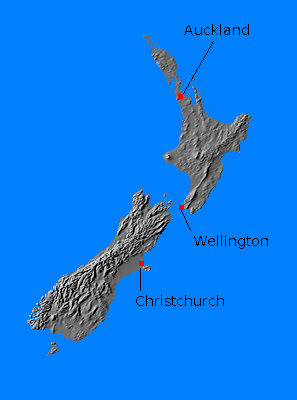![]() The Pacific War Online Encyclopedia
The Pacific War Online Encyclopedia
|
| Previous: New York Class, U.S. Battleships | Table of Contents | Next: New Zealand Order of Battle |

New Zealand was a self-governing Dominion of the British Empire in 1941. Consisting of two large and several small islands with a total land area of about 172,000 square miles (445,000 km2), the country was mostly agrarian, with a population of just 1.6 million persons. It managed to mobilize 157,000 troops during the war, an impressive fraction of its population, and these generally proved to be very capable troops, serving with distinction in North Africa and Italy as well as the Pacific.
The larger South Island has a mountainous spine, the Southern Alps, reaching to 13,000' (4000m). This is bordered on the east by a coastal plain and the city of Christchurch. North Island is also rugged, with a number of large dormant volcanoes. The major city is Auckland, with port facilities to both east and west on either side of the Northland Peninsula. The capital city of New Zealand, Wellington,
was deliberately located at the southern tip of North Island, just
across from South Island, to forestall a movement to make South Island
a separate Dominion. Both islands have a temperate climate.
Rainfall is ample except in a few locations on South Island in the rain
shadow of the mountains.
Prior to the start of the Pacific
War, New Zealand had sent
its best division, the 2nd,
to Africa.
This left a division of
World War I veterans to guard New Zealand itself, plus a brigade in Fiji
and scattered small garrisons elsewhere. Unlike Australia, New Zealand
did not demand the return of its division from Europe, a decision made
easier by New Zealand's greater distance from the Japanese threat. A
second regular
division was formed
starting in mid-1942, but there were never enough troops to raise more
than two
brigades to serve in the division,
which was disbanded in 1944 after
seeing
some tough combat in the Solomon
and Bismarck
Islands. The Royal New Zealand Air
Force was well-trained but small, while the Royal New Zealand Navy
consisted of
a handful of light
cruisers and destroyers
that operated as virtually an
integral part of the U.S.
Navy. New Zealand's ports were
important rear bases early in the Pacific War, but became less
important as the Allied counteroffensive moved forward.
| New Zealand Military Forces (Puttick; at Auckland) | ||||
| 2 NZEF Corps (Suva) | ||||
| 8 Brigade Group (Cunningham) | 8 battalions, plus platoons on Rorotonga and Fanning, the latter including an artillery battery. Also a battery on Suva. Generally short on heavy weapons. | |||
| Fiji Squadron (at Nadi) | Command hierarchy and composition uncertain | |||
| 22 F2A3 Buffalo | ||||
| Northern Military District (Auckland) | ||||
| 1 Auckland Battalion | ||||
| 1 Mounted Rifles | ||||
| 1 Regiment | ||||
| Central Military District (Wellington) | ||||
| 1 Wellington Battalion | ||||
| 2 Mounted Rifles | ||||
| 2 Brigade | ||||
| Southern Military District (Christchurch) | ||||
| 1 Canterbury Battalion | ||||
| 3 Mounted Rifles | ||||
| 3 Brigade | ||||
| Royal New
Zealand
Air Force (Saunders; at Wellington)
|
||||
| 488 Squadron (at Kallang) | ||||
| 32 F2A3 Buffalo | ||||
| 5 Squadron (at Nadi) | ||||
| 4 Singapore | ||||
| H.M. New Zealand Squadron (at Auckland) | ||||
| CL Achilles | ||||
| CL Leander | ||||
References
http://www.freeport-tech.com/WWII (accessed 2002; now defunct)
The Pacific War Online Encyclopedia © 2007, 2009-2010 by Kent G. Budge. Index